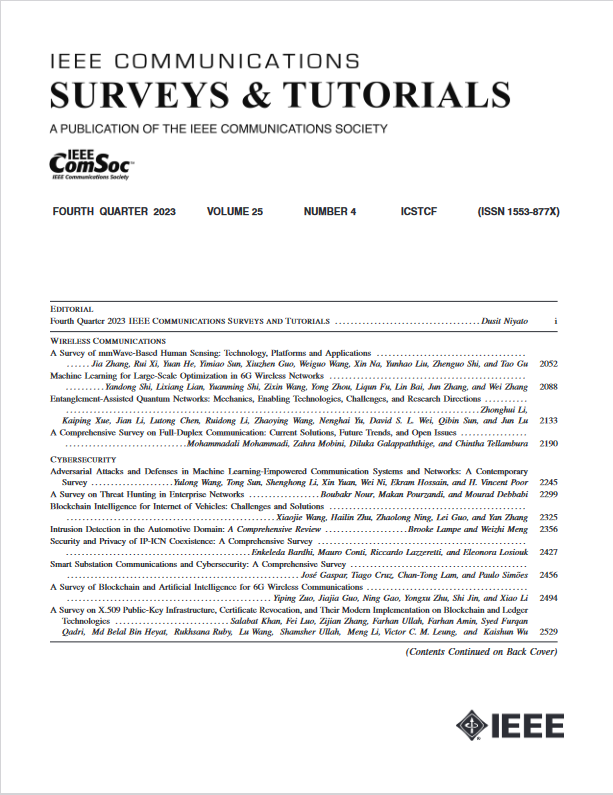A Survey on Threat Hunting in Enterprise Networks
IF 34.4
1区 计算机科学
Q1 COMPUTER SCIENCE, INFORMATION SYSTEMS
引用次数: 2
Abstract
With the rapidly evolving technological landscape, the huge development of the Internet of Things, and the embracing of digital transformation, the world is witnessing an explosion in data generation and a rapid evolution of new applications that lead to new, wider, and more sophisticated threats that are complex and hard to be detected. Advanced persistence threats use continuous, clandestine, and sophisticated techniques to gain access to a system and remain hidden for a prolonged period of time, with potentially destructive consequences. Those stealthy attacks are often not detectable by advanced intrusion detection systems (e.g., LightBasin attack was detected in 2022 and has been active since 2016). Indeed, threat actors are able to quickly and intelligently alter their tactics to avoid being detected by security defense lines (e.g., prevention and detection mechanisms). In response to these evolving threats, organizations need to adopt new proactive defense approaches. Threat hunting is a proactive security line exercised to uncover stealthy attacks, malicious activities, and suspicious entities that could circumvent standard detection mechanisms. Additionally, threat hunting is an iterative approach to generate and revise threat hypotheses endeavoring to provide early attack detection in a proactive way. The proactiveness consists of testing and validating the initial hypothesis using various manual and automated tools/techniques with the objective of confirming/refuting the existence of an attack. This survey studies the threat hunting concept and provides a comprehensive review of the existing solutions for Enterprise networks. In particular, we provide a threat hunting taxonomy based on the used technique and a sub-classification based on the detailed approach. Furthermore, we discuss the existing standardization efforts. Finally, we provide a qualitative discussion on current advances and identify various research gaps and challenges that may be considered by the research community to design concrete and efficient threat hunting solutions.企业网络威胁搜索研究综述
随着快速发展的技术格局、物联网的巨大发展以及数字化转型的拥抱,世界正在见证数据生成的爆炸式增长和新应用的快速发展,这些新应用导致了新的、更广泛的、更复杂的威胁,这些威胁复杂且难以检测。高级持久性威胁使用连续的、秘密的和复杂的技术来获得对系统的访问,并在很长一段时间内保持隐藏,从而产生潜在的破坏性后果。这些隐形攻击通常无法被先进的入侵检测系统检测到(例如,LightBasin攻击于2022年被检测到,自2016年以来一直活跃)。事实上,威胁行为者能够快速而智能地改变他们的策略,以避免被安全防线(例如,预防和检测机制)检测到。为了应对这些不断变化的威胁,组织需要采用新的主动防御方法。威胁搜索是一种主动的安全措施,用于发现可能绕过标准检测机制的隐蔽攻击、恶意活动和可疑实体。此外,威胁搜索是一种迭代方法,用于生成和修改威胁假设,努力以主动的方式提供早期攻击检测。主动性包括使用各种手动和自动化工具/技术测试和验证初始假设,目的是确认/驳斥攻击的存在。本调查研究了威胁搜索的概念,并对现有的企业网络解决方案进行了全面的回顾。特别地,我们提供了基于所使用的技术的威胁狩猎分类和基于详细方法的子分类。此外,我们还讨论了现有的标准化工作。最后,我们对当前的进展进行了定性讨论,并确定了研究社区可能考虑的各种研究差距和挑战,以设计具体和有效的威胁狩猎解决方案。
本文章由计算机程序翻译,如有差异,请以英文原文为准。
求助全文
约1分钟内获得全文
求助全文
来源期刊

IEEE Communications Surveys and Tutorials
COMPUTER SCIENCE, INFORMATION SYSTEMS-TELECOMMUNICATIONS
CiteScore
80.20
自引率
2.50%
发文量
84
审稿时长
6 months
期刊介绍:
IEEE Communications Surveys & Tutorials is an online journal published by the IEEE Communications Society for tutorials and surveys covering all aspects of the communications field. Telecommunications technology is progressing at a rapid pace, and the IEEE Communications Society is committed to providing researchers and other professionals the information and tools to stay abreast. IEEE Communications Surveys and Tutorials focuses on integrating and adding understanding to the existing literature on communications, putting results in context. Whether searching for in-depth information about a familiar area or an introduction into a new area, IEEE Communications Surveys & Tutorials aims to be the premier source of peer-reviewed, comprehensive tutorials and surveys, and pointers to further sources. IEEE Communications Surveys & Tutorials publishes only articles exclusively written for IEEE Communications Surveys & Tutorials and go through a rigorous review process before their publication in the quarterly issues.
A tutorial article in the IEEE Communications Surveys & Tutorials should be designed to help the reader to become familiar with and learn something specific about a chosen topic. In contrast, the term survey, as applied here, is defined to mean a survey of the literature. A survey article in IEEE Communications Surveys & Tutorials should provide a comprehensive review of developments in a selected area, covering its development from its inception to its current state and beyond, and illustrating its development through liberal citations from the literature. Both tutorials and surveys should be tutorial in nature and should be written in a style comprehensible to readers outside the specialty of the article.
 求助内容:
求助内容: 应助结果提醒方式:
应助结果提醒方式:


